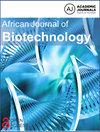Propagation of cochineal scale insect free cactus (Opuntia ficus-indica) by in vitro regeneration culture technique in Tigray, Ethiopia
引用次数: 0
Abstract
Cactus in northern Ethiopia is an endangered plant due to the attack by cochineal scale insect (Dactylopius coccus). The aim of this study was to micro propagate disease-free and cochineal resistance cactus pear by in vitro regeneration culturing technique. The study started with young cladodes carefully removed from mother plants. The surface-sterilized 1 cm2 cladode with one areole was cultured on shoot initiation MS media supplemented with 0, 0.5, 1.0, and 1.5 mg/l BAP alone. The already established explants were cultured on shoot multiplication media fortified with BAP at 0, 1.0, 2.0, and 3.0 mg/l. The proliferated cultures were inoculated for rooting on half-strength MS media supplemented with NAA alone at 0, 0.5, 1.0 and 1.5 mg/l. The MS medium appended with 0.5 mg/l BAP produced significantly the highest shoot number per explant (3 ± 1) and highest micro shoot length (3.27 ± 0.40). The highest multiplication factor (9.93 ± 2.25) was observed on a medium containing 1 mg/l BAP while the highest shoot lengths or elongation (3.03 ± 0.26) were observed on the medium containing 2 mg/l BAP. The best highest root number (6.06 ± 0.92) was recorded on the half MS Basal medium containing 0.5 mg/l NAA and highest root length (3.03 ± 0.27) was verified on the half MS Basal medium containing 1.0 mg/l NAA. The well-rooted plantlets were transferred for acclimatization purposes using coco peat substrate and 100% of the plants survived and established as vigorous plants under modern greenhouse conditions. The creation of a successful micro propagation method that allows for the production of more than 10,000 rooted plantlets from a single longitudinally divided shoot explant in just short period of time.埃塞俄比亚提格雷地区无胭脂虫蚧仙人掌(Opuntia ficus-indica)离体再生培养技术的繁殖
埃塞俄比亚北部的仙人掌因受到胭脂虫(Dactylopius coccus)的侵害而濒临灭绝。本研究的目的是利用离体再生培养技术对无病、抗胭脂虫的仙人掌梨进行微繁。这项研究从小心翼翼地从母体植物中取出幼小枝开始。表面灭菌的1 cm2 1孔枝在单独添加0、0.5、1.0和1.5 mg/l BAP的芽生MS培养基上培养。将已建立的外植体在添加0、1.0、2.0和3.0 mg/l BAP的芽部增殖培养基上培养。将增殖后的培养基分别接种于添加0、0.5、1.0和1.5 mg/l NAA的半强MS培养基上生根。添加0.5 mg/l BAP的MS培养基每外植体芽数最高(3±1)个,微芽长最高(3.27±0.40)个。在BAP含量为1 mg/l的培养基上,增殖系数最高,为9.93±2.25;在BAP含量为2 mg/l的培养基上,茎长或伸长最高,为3.03±0.26。0.5 mg/l NAA的半MS基液中根数最多,为6.06±0.92;1.0 mg/l NAA的半MS基液中根长最多,为3.03±0.27。在现代温室条件下,将根系良好的植株转移到可可泥炭基质中进行驯化,100%的植株成活并成为健壮的植株。创造了一种成功的微繁殖方法,可以在很短的时间内从一个纵向分裂的芽外植体中产生超过10,000个有根的植株。
本文章由计算机程序翻译,如有差异,请以英文原文为准。
求助全文
约1分钟内获得全文
求助全文

 求助内容:
求助内容: 应助结果提醒方式:
应助结果提醒方式:


